Essential Information
Is a Tandem Skydiving Experience for You?
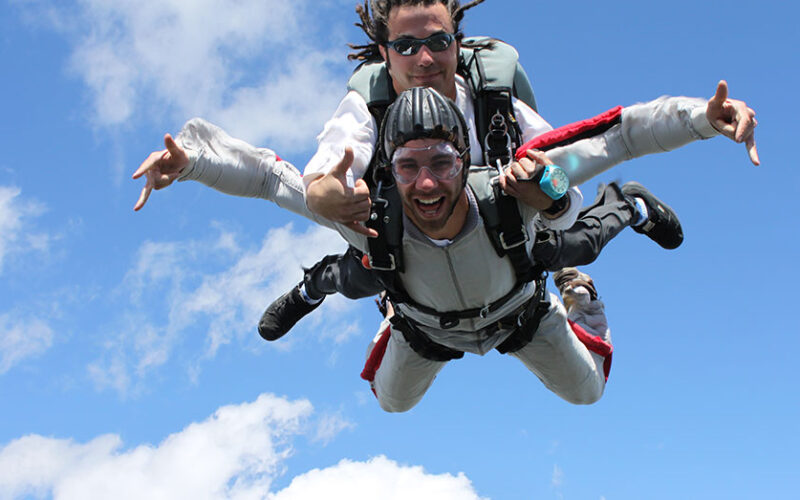
So you’re looking to make your first jump? You’ve come to the right place! We take you through what to expect during your first tandem skydive. Before we walk through the first-time tandem experience, let’s take a look at what a tandem skydive is so you’ll know what to expect:
Contents
What is a Tandem Skydive?
Tandem skydiving was developed and adopted during the 1980’s and quickly grew to be the go-to first time skydiving method. During a tandem, you, the student, are attached to an experienced tandem master. As a pair, you’ll make a full skydive including freefall, canopy flight, and landing.
If you’re looking for a full rundown on the subject, our beginners guide to tandem skydiving will take you through everything you need to know before you make your first jump.
The Thrilling Experience of a Tandem Skydive
Setting the Scene – So you’ve nervously booked your first jump. You impatiently waited for the day to arrive, maybe you lost some sleep, maybe you considered canceling but didn’t. The day arrives and you hop in the car and drive out to the skydiving facility where you’ll make your first jump.
After checking in, signing a waiver, watching a training video, and putting on your gear – the moment is finally here. As if in an action movie you, your tandem master, and the rest of the jumpers walk to the plane. The roar of the engines blast you with a stiff breeze as you board the plane, but this breeze is nothing compared to what you’re about to experience!
As you settle into the plane, you’ll click together your seatbelt for what is likely to be the most nerve-wracking plane ride of your life. As the plane climbs to altitude everything outside gets smaller and smaller until nothing seems familiar.
Maybe this is a view you’ve seen from a plane before, but believe me, it’s never been such a real sight as now.
Ready, Set… GO!
As the plane approaches jump altitude, you’ll have been preparing to jump. Your tandem master will connect your harness, secure your goggles, and equipment safety checks will be performed. Looking around at others in the plane, you’ll probably see smiles, nervous grins, and fist bumps for encouragement.
It doesn’t matter how cool and collected you look on the outside – as a first-time jumper your nerves will be on fire. Your palms will be sweating and your heart will be pounding in your chest. As the plane reaches jump run over the dropzone, the call for door open comes and suddenly and the roar of the wind will fill the plane.
A small green light flicks on, a call for ready to jump is given. Maybe you’re first out, maybe you watch others disappear into the unknown below. When it’s your turn to jump you’ll make a very, very real slide up to the edge of the door. I promise, no matter what you did to prepare, you didn’t know what you were in for until NOW.
One look down and your mind nearly explodes with the realization of what you’re about to do. The tandem master gives the ready, set, go as you both push off an leave the aircraft into a completely new world…
The Wonderful World of Freefall
Leaving the plane you’ll be one of the luckiest humans alive and get to experience the true freedom. You’ll be immediately supported on the wind, preventing any sort of ‘dropping feeling’ in your stomach. Adrenaline will explode into your veins as you experience a set of completely new sensations.
The first few seconds are often so overwhelming that it is hard to remember details of what is happening. As you settle into freefall, you’ll rest belly-to-earth on a cushion of wind as you and the tandem master fall towards earth.
Because you are so far from everything, there is no reference point to measure speed or trigger those with a fear of heights. Maybe a distant cloud gives you some reference, but that’s about it. The overwhelming rush of the wind leaves only the ‘whoo-hoos’ and screams of joy to be heard between you and the tandem master.
As you fall back to earth at speeds of 100mph and more, you’ll get to enjoy the most spectacular view in the world. Eventually, it is time to open the canopy. The tandem master will deploy the main parachute which will open overhead as the rush of the wind settles.
The Canopy Flight Back to Earth
With a parachute open overhead, you’ll relax into another completely new experience. With the wind at your front, you and the tandem master push forward through nothing, flying freely still thousands of feet above the ground.
Look down and your feet dangle above a vast sea of nothingness with only the support of the canopy above. For 5 minutes or more, you’ll get to enjoy 360-degree breathtaking views.
As you descend down to the ground the tandem master will enter a flight pattern to eventually land in a designated landing area. You’ll follow the tandem master’s instructions and either land standing or slide in on your butt. Back on the ground, you unhook from the tandem master and kiss the ground as you arrive safely back.
Why Should You Make Your First Skydive?
There is no doubt that the thrill of skydiving is simply unmatched. As a tandem passenger, you’re in for an unforgettable experience. Seeking one of life’s most intense thrills keeps skydiving growing each year. During a skydive, any problems or concerns back on the ground are 100% gone. The overwhelming reality of jumping from a plane leaves no mental space for other thoughts. If there ever was a drug-free full mental reset, this is it!
Common Reasons People Make Their First Skydive:
- Cross skydiving off their bucket list.
- Recieve a jump voucher as a gift for a special occasion.
- Bachelor or bachelorette parties.
- As an introduction to skydiving before becoming a student.
- To satisfy your adrenaline fix.
- Pure curiosity!
While the adrenaline rush is the biggest draw to make your first jump, a large number of first-timers find that the freedom of a jump and the calm of canopy flight is actually the most memorable aspect. Regardless of your reasons, the shared conclusion is that the experience is an amazing one-of-a-kind memory that you’ll never forget.
Each year hundreds of thousands of tandems are made. Will you join them? If you’re ready to jump you can find a skydiving center near you in our database.
Frequently Asked Questions Before a First Jump
The following are frequently asked in regards to the tandem skydiving experience:
Do you get a dropping feeling in your stomach when you jump?
No. The aircraft you’ll jump from has enough forward speed that there is wind resistance against your body when you jump. This prevents the dropping feeling you get when you jump off a cliff or bridge into the water. With that being said, it is possible to get this feeling when skydiving if you a stationary aircraft like a hot air balloon or helicopter.
Can friends or family jump together as a group?
This one depends on the aircraft available at the skydiving facility. Larger groups may be able to take the same ride to altitude and jump as a group. That doesn’t mean you’ll be in freefall together, but you will fly up in the plane together. If this is your goal, call ahead to the skydiving center. You might also be able to take advantage of a group discount.
How high do you jump from?
This will vary from dropzone to dropzone. Typically a tandem skydive is made from roughly 13,500 feet above ground level. This jump altitude can vary depending on the type of aircraft being flown, elevation above/below sea level at the jump center, and options that the dropzone offers.
How fast do you fall?
Tandem freefall speeds are going to vary from jumper to jumper. Smaller, lighter tandems will fall slower. Larger, heavier tandems will fall faster. The drogue chute acts to slow down during freefall. Freefall speeds average around 110 – 130 mph. The most commonly quoted average is fairly accurate at 120 mph.
How long does the skydive last?
This one directly correlates to how high you jump from. Assuming a tandem falls at roughly 120 miles per hour, that equates to 176 feet per second. A tandem canopy opens the parachute at approximately 4,000 feet above ground level (AGL). To calculate time in freefall, we take (Jump Altitude – Opening Altitude) / 176 = seconds in freefall.
Use the following reference chart to find how long a tandem skydive from various jump altitudes will last:
| Jump Altitude | Feet in Freefall | Time in Freefall |
| 8,000 | 4,000 | 23 Seconds |
| 10,000 | 6,000 | 34 Seconds |
| 12,000 | 8,000 | 45 Seconds |
| 14,000 | 10,000 | 57 Seconds |
| 16,000 | 12,000 | 68 Seconds |
| 18,000 | 14,000 | 80 Seconds |
Using this chart, we can determine that the average tandem skydive has roughly 1 minute of freefall time.
How long does the parachute ride last?
A tandem parachute should be overhead at 4,000 feet above ground level. Depending on the weight of the tandem, the average the amount of time under canopy is usually around 4-5 minutes.
Will I be able to breathe in freefall?
Yes. Breathing in freefall is no more difficult than breathing while on a motorcycle or with your head out the window of a car. The overwhelming thrill of skydiving may take your breath away for a moment, but it will not prevent you from breathing normally otherwise.
Can I still jump if I am scared of heights?
YES! People who are scared of heights find that tandem skydiving is something that doesn’t trigger this fear. This is simply because there are no nearby reference points during a jump. Everything is so far away that the only way to tell how fast you’re actually moving is if you pass some nearby clouds.
Published: April 29, 2018 | Last Updated: July 28, 2022
Don’t miss an update!
Join our mailing list for the latest indoor skydiving updates delivered directly to your inbox.

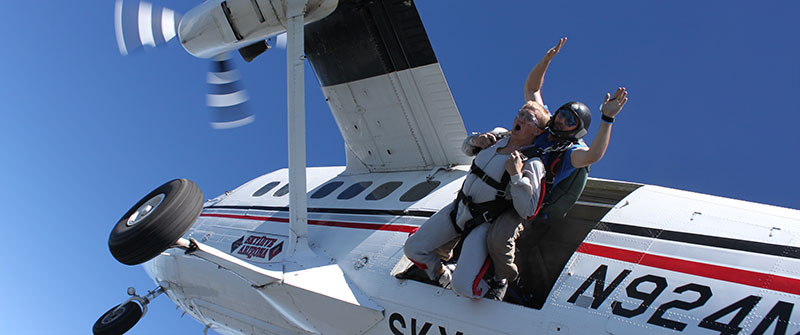

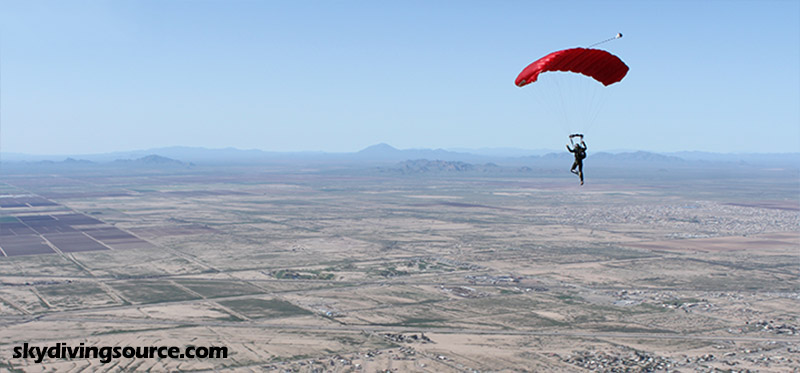
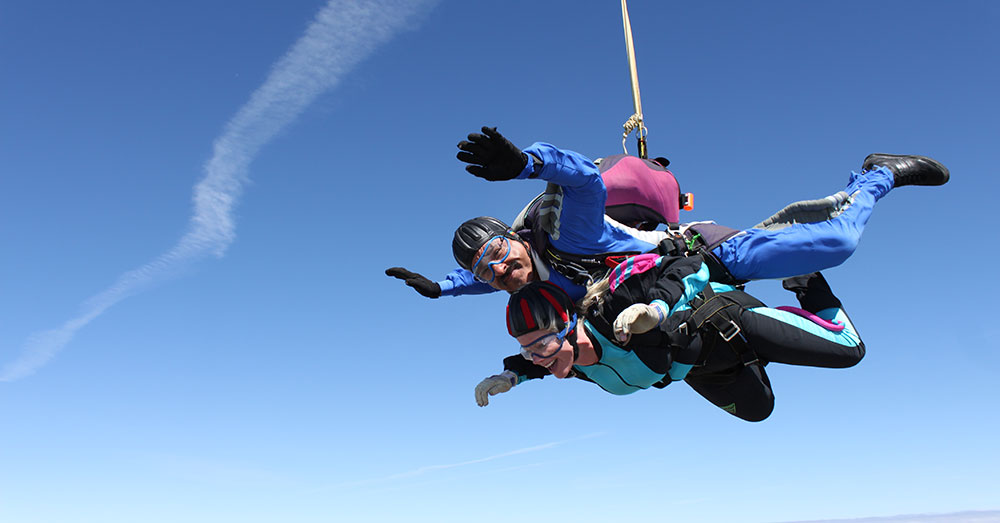
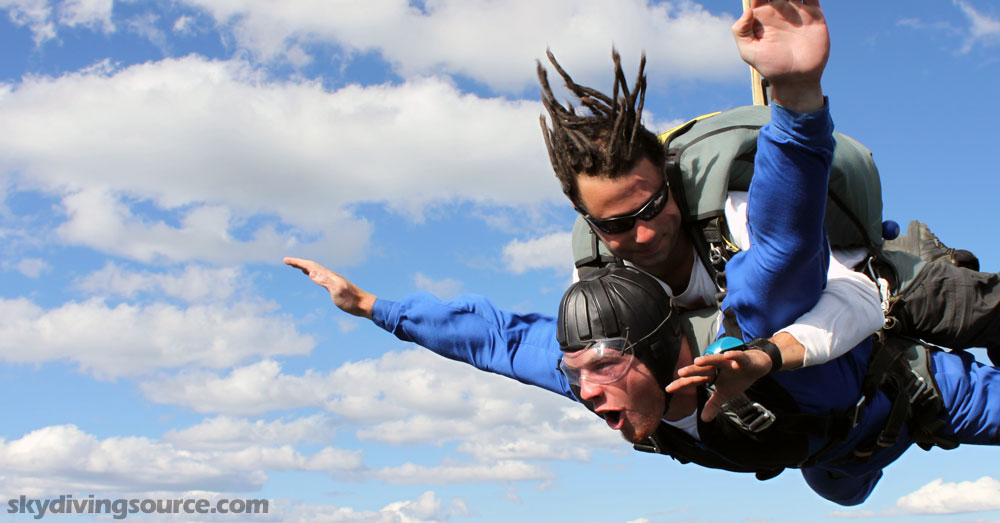
I am wondering if we are still jumping on Saturday if it rains. Do we still jump?
How much is the probability or possibility the parachute is not open? there are an alternative parachute?
If it doesn’t open you don’t have to worry for long.
You always have a reserve parachute and tandem opening altitudes are about 2,000 feet higher than normal required opening altitudes so that the tandem instructor has more time to deal with any problems.
does the first jump Have to be tandem or is a static line jump available?
Some drop zones will do static line jumps. You’re best off speaking with them directly to find out what options they have.
Hi to you, just wondering what age? Wt does a person need to be the do their 1st Tandom jump ? 15th birthday. 56.kg’s.
Kind regards
Ange 🙂